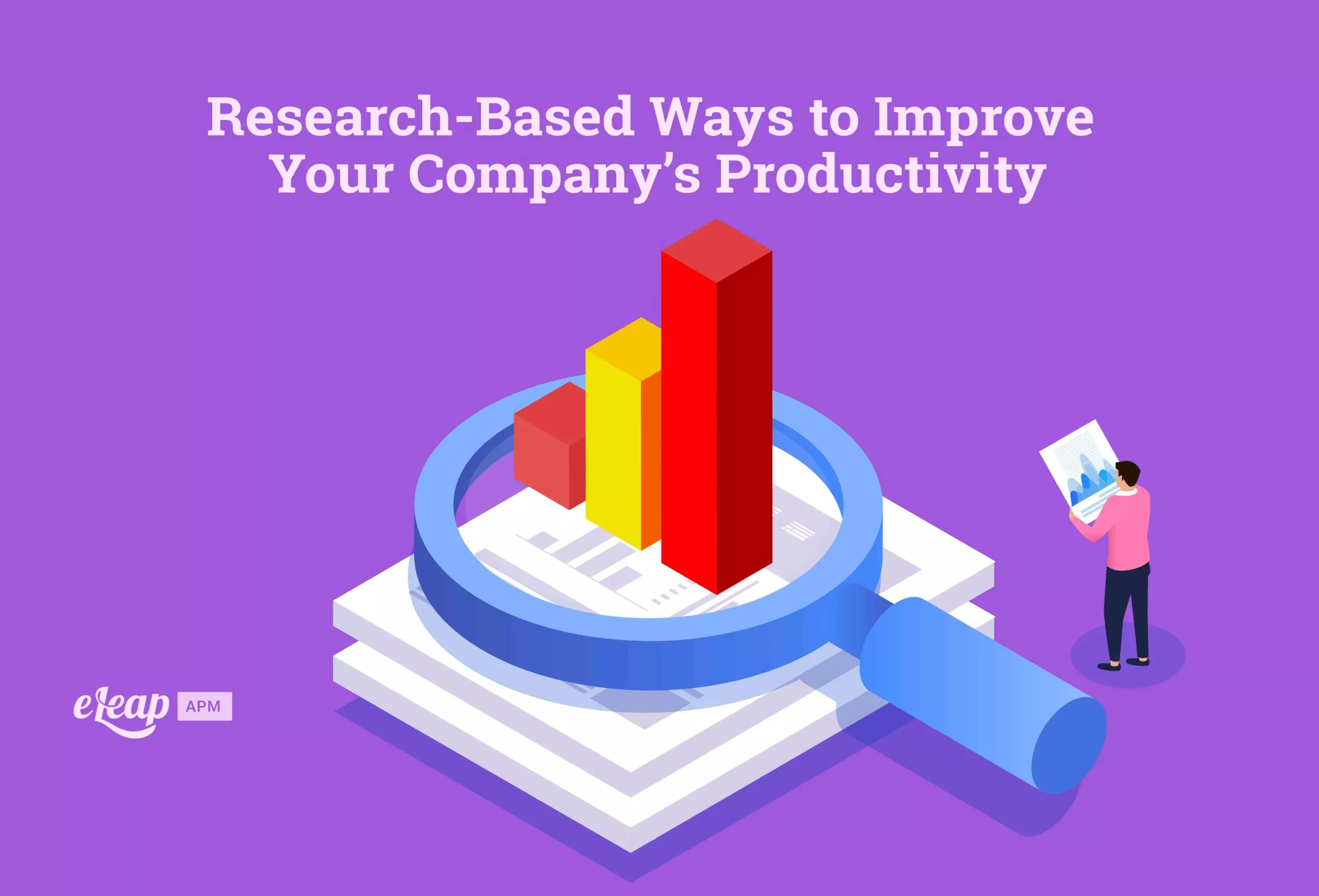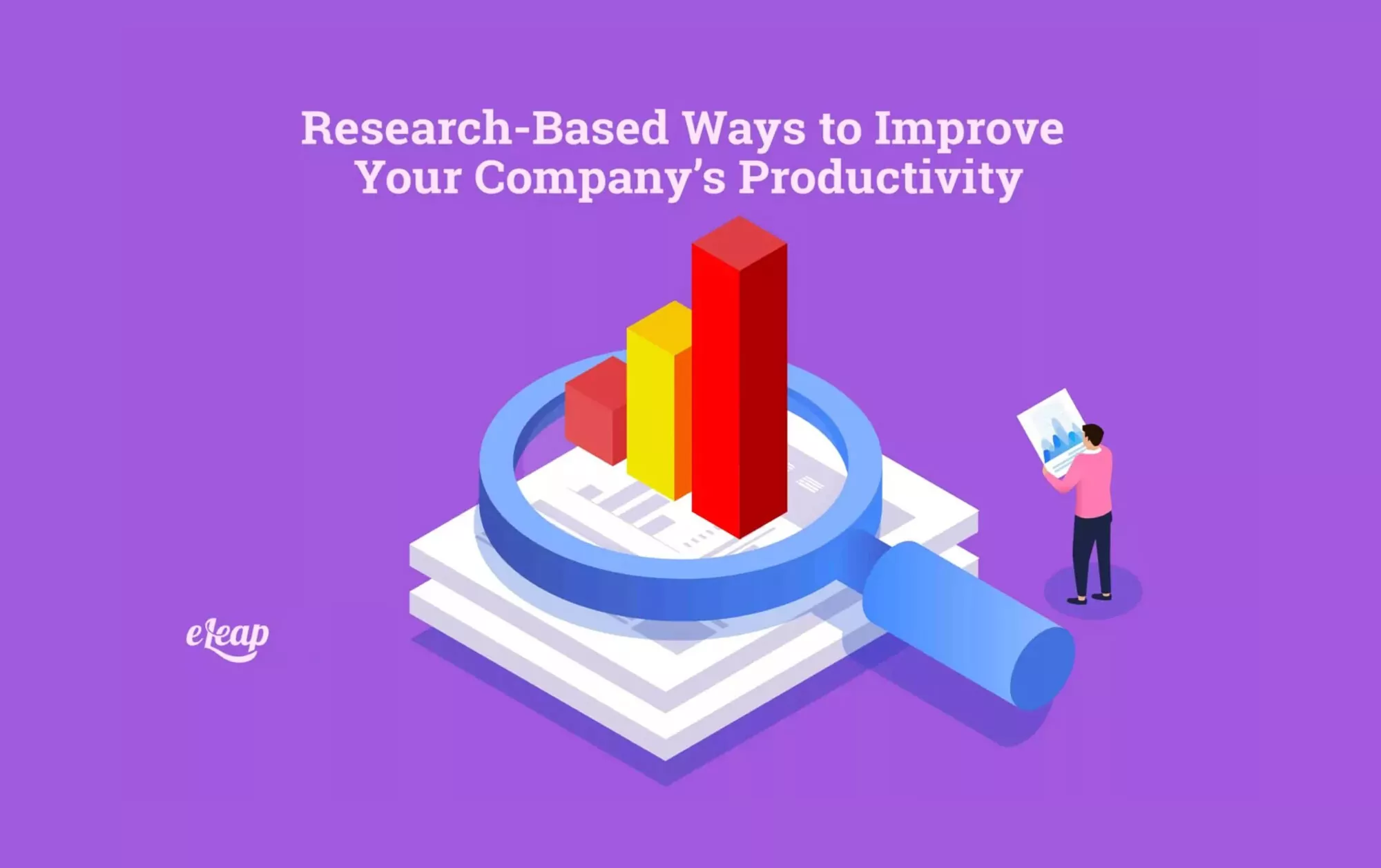Research-Based Ways to Improve Your Company’s Productivity

As a manager, you want to improve productivity among your team members as well as your own. As busy as most people are these days, it seems to make sense that people are more productive and efficient. Explore how eLeaP®’s Performance Management Platform can simplify evaluations, boost productivity, and drive measurable results.
After all, we have our phones with us everywhere we go. Coffee is as much a staple as water. People listen to development podcasts both during the commute and while they’re exercising. And who needs sleep?
The real truth, though, is that instead of improving productivity, all these regular activities drain us and make us inefficient. We don’t have real connections with our colleagues, and constructive feedback is nonexistent. Top that off with overworked and underappreciated employees who are treated as tools for profit rather than human beings, and it’s a recipe for disaster.
Improving productivity among your workforce starts with understanding yourself as a leader. You first need to recognize your limitations and boundaries so that you can appreciate them in your employees.
New science and research focus on a leadership paradigm prioritizing a healthy work-life balance, mental and emotional health, physical well-being, and soft skills such as compassion, non-verbal communication, and emotional intelligence.
Some of these ideas might seem counterintuitive at first. However, once you understand them and how they relate to improving productivity in your organization, you’ll be champing at the bit to learn more and implement these into your leadership style.

Four Ways to Improve Productivity
Each of these ideas improves productivity in unique ways. Combine all four, and you’ve got a bullet-proof solution to raise employee engagement and increase production.
Neuroplasticity
Your brain is a living, dynamic part of you. It’s never done changing and growing. Not only that, but society is constantly learning about new ways that the brain works and responds, as well as discoveries about:
- Brain chemistry
- Mental health
- The science behind productivity.
People used to think we learned everything we needed to know as children and adolescents. Then, as adults, we hit our limit for intelligence and capability. This thinking still prevails in certain circles or with people who have what we call a “fixed mindset.”
Research shows, though, that a “growth mindset” allows us to learn and change with greater resilience. We know that setting ourselves up for success gives a greater chance for learning to take root. Humans rewire their brains for growth by incorporating practices such as:
- Healthy diets
- Regular exercise
- Meditation and breath work
- Safe emotional, mental, and physical environments
Think about your employees as dynamic humans instead of as tools for profit. Your job is to create a low-stress environment with appropriate challenges and supportive leadership. Model a healthy lifestyle so that they know you value boundaries.
These investments help employees become the best versions of themselves. Thus, they bring their best work to your organization, benefiting everyone.
“The Lizard Brain” and Its Connection to Stress
Your brain is divided into three parts. No, not left-brain, right-brain, and something else. We’re talking about the stem and cerebellum, the limbic system, and the neocortex.
We’ll break that down in a minute, but what’s important is that each of these brain sections defaults energy to the more primitive section when it’s under stress. The more developed sections of the brain can’t function when the rest of the brain isn’t taken care of.
The brain stem and cerebellum are at the very base of your brain, connected to your spinal cord. This is called “the lizard brain” because it’s the only part present in reptiles. It controls your most basic functions that you don’t even think about, such as breathing, digestion, and blood flow.
The limbic system is responsible for feelings and emotions. All mammals share this system. (Snakes don’t feel jealousy or love, right?) This section controls our behavior and is responsible for memories, relationships, and social development.
Humans and some primates evolved even further, though, to develop what’s called a neocortex (also known as the frontal lobe). This part of the brain gives us language, creativity, and abstract thinking.
Okay… what does this have to do with improving productivity? People need to access their frontal lobe to create, innovate, and work efficiently. A hostile or toxic work environment forces people’s brains to revert to that reptilian brain system where they’re simply trying to evade danger.
As a manager, you must make people feel safe instead of afraid. Employees who constantly worry about being fired or receiving demeaning feedback suffer from high adrenaline and cortisol levels. This shuts down creativity and efficiency, resulting in low-level work and frustrated employees.
A Healthy Mix of Focus and Rest Equals High Productivity
You’ve heard about circadian rhythms, right? These are our instinctual pulls toward awake and asleep hours. Usually, people’s rhythms follow a 24-hour cycle that is closely related to light and dark. Healthy, appropriately stimulated, and nourished bodies want to wake up when it’s daytime and rest when it’s nighttime.
However, we’ve come away from this in our modern society filled with electricity, blue light, and the more-more-more mentality. We don’t know when or how to shut our bodies and minds down, so we “fix” it with caffeine, alcohol, television, and sleep aids.
It’s no wonder, then, that we don’t realize or connect to our natural rhythms for work, either.
Most working Americans say that the first thing they do when they wake up is pick up their phones and check for messages and emails. They rush through a morning routine, thinking about everything they must do that day. They sit in traffic, returning phone calls, listening to audiobooks, or getting a head start on work if they are rideshare.
Then, they sit at a desk for eight-plus hours a day, tackling numerous projects, going in and out of meetings, checking off to-do lists, and often feeling like they didn’t get anything done. (To be fair, people who stay home with their children often feel this way, too.)
This is not ideal for productivity. It goes against our ultradian rhythm—the flow between when we’re more and less focused. In reality, what works is focusing on a particular task for 90 minutes, more or less. In between, a 10–20-minute break helps us re-energize and get ready to tackle something else.
To help yourself tap into this ultradian rhythm, set a timer (on a regular clock, not your phone!), and when it goes off, get to a good stopping point. Then, take a quick walk around the block, grab a snack, or do some easy stretches. Tune into your body.
Soon, you won’t need the timer. You’ll be more aligned with your body’s natural signals so that when you feel yourself get tired, groggy, or restless, you’ll know that it’s time for a break.
As a manager, allow your employees the autonomy to set their break times and schedules. We all have different rhythms and states of flow (this idea comes next), so it’s unproductive to keep people on a strict break schedule. People who have ownership over their work are more productive.
Get into the State of Flow
Think about the last time you were alone with a good book, with nothing else on your mind. Or when you were at lunch with a good friend, talking endlessly over delicious food and drinks. Or what about when you’re playing a new, exciting video game where you just can’t wait to get to that next level? Time flies, right?
This is possible in the workplace, too. The environment needs to be low-stress, positive, and enjoyable, giving space for creativity and innovation.
Let’s take the video game example. What makes good games so enjoyable and—for lack of a better word—addictive? They have:
- Variety
- Appropriately scaffolded challenges
- Clear goals
- Immediate feedback
In his bestselling book Flow, author Mihaly Csikszentmihaly discusses that an enjoyable game and an enjoyable job share many of the same qualities. He says when a job resembles a game, people not only work better but they actually enjoy working.
How do we get into this flow state ourselves? It starts by eliminating distractions. Turn on the “do not disturb” function on your phone or computer when you’re beginning one of those 90-minute chunks discussed above. Then, respond to other tasks when your focus isn’t pulled in several different directions.
As a manager, ensure that you align people’s tasks with their purpose and challenge them appropriately. Set concrete goals and follow up with them to ensure that they are on track and have everything they need. Give constructive, positive feedback often, and deliver your hard conversations with empathy.
Conclusion
Your natural skills and abilities got you to the position of leadership you are in. However, your position and your organization continue to thrive as you learn new things about people, environments, and relationships.
The more you understand how your team members work and what they need on a basic level, the more you create an environment that improves productivity and develops employees with high morale.